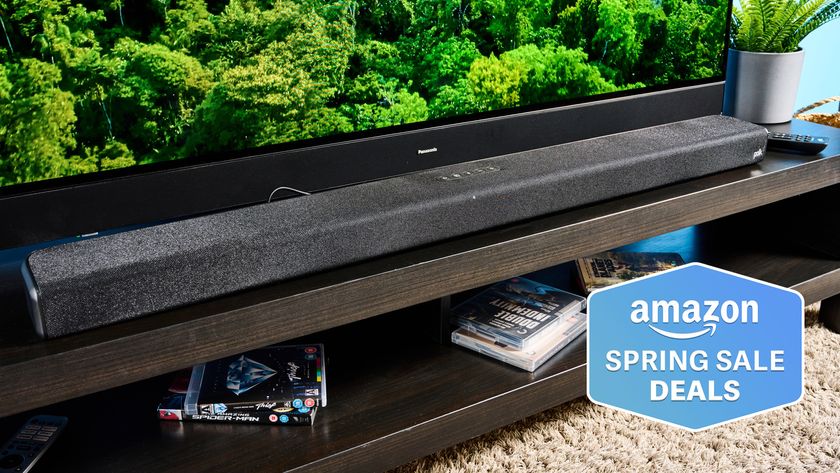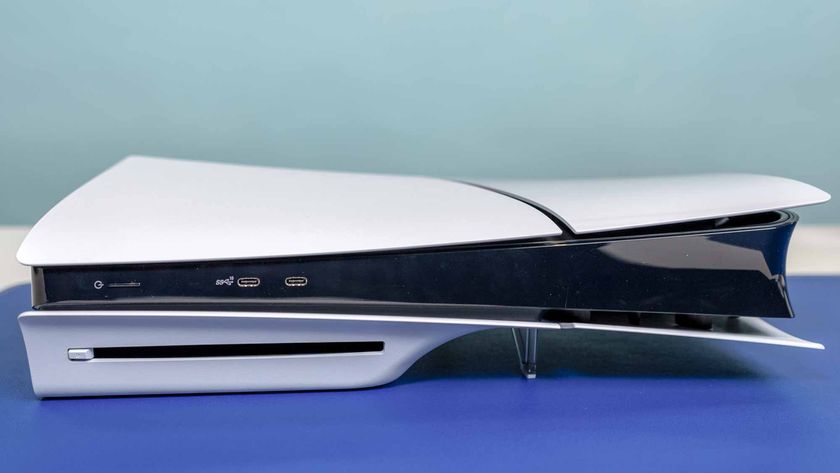The best soundbars of 2025: Tested, rated and reviewed
The best soundbars from B&W, Samsung, Sonos, Sony, and more

It is a truth universally acknowledged, that a single TV in need of decent sound, must be in want of one of the best soundbars. Go ahead — watch a movie with your built-in TV speakers, and you'll soon find that it's missing something that you get at the movie theatre. I, personally, hate TV speakers. I watch a lot of movies, and I want more than the tinny, thin-sounding hardware that TV manufacturers pack into their displays.
If you want to bring the meat back to your action movie explosions and the clarity back to your dialogue, then you're best off with a soundbar. I'm a big fan of a soundbar, thanks to their sound quality size compared to a full surround setup. I'm also lucky enough to have tested some of the best around — most recently my top pick for best soundbar, the Sonos Arc Ultra.
It's an incredible bar, and even better when connected to the separately available subwoofer. I found it full of bass and low-end for spectacular explosions, and then the Dolby Atmos performance outperformed everything else around. When I watched Masters of the Air on Apple TV+, I was right alongside those bomber crews as they flew over Europe.
Below, you'll find my other top picks for soundbars based on your needs. Afterall, not everyone even has the space for one of the really long ones, and you might not be interested in the surround performance and want something that'll fit into your living room without standing out. These are the best soundbars around based on Tom's Guide's testing.
The Quick List

Price ★★★★☆
Sound ★★★★★
Surround ★★★★★
Sonos' latest soundbar is a surround sound and Dolby Atmos triumph. All of the weaknesses of the last model have been worked out, and the sound it produces is excellent.

Price ★★★★★
Sound ★★★☆☆
Surround ★★★★☆
This Dolby Atmos soundbar is a solid performer that won't break the bank, but you'll want to spring for a subwoofer if you really want strong bass.

Price ★★★☆☆
Sound ★★★★★
Surround ★★★★☆
Bose's slick-looking (and sounding) flagship soundbar is a great way to get Dolby Atmos in your living room. It's filled with smart features too, so that you can bring voice support to your TV stand.
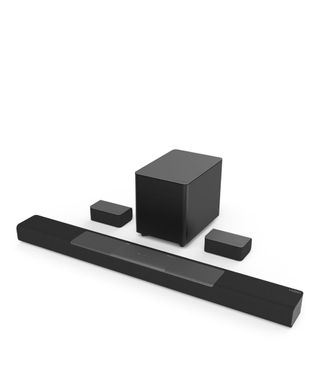
Price ★★★★★
Sound ★★★★☆
Surround ★★★★☆
This Dolby Atmos-equipped soundbar doesn't cost a whole lot, but it includes surround speakers for that excellent movie hit. There's a sub in the box as well — and it sounds great to boot.
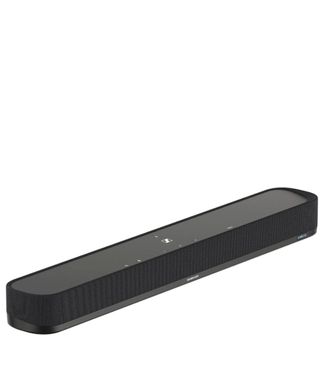
Price ★★★★☆
Sound ★★★★★
Surround ★★★☆☆
Sennheiser's Ambeo mini soundbar is a great option for smaller rooms, and still features Dolby Atmos for that big, Spatial Audio kick. It'll perfectly below smaller TV sets as well.

Sony's HT-2000 blew our tester away with effortless, built in bass that negated the need for a subwoofer. Dialogue is clear and crisp as well, and the extra Atmost sound went a long way for surround performance.
Click to load more

The Polk Signa S4 is a great way to get a subwoofer and a soundbar in the same package without breaking the bank. It sounds huge, and comes in at a great price.
About the author

I oversee the audio content that goes up on Tom’s Guide, and maintain the site's buying guides for headphones, wireless earbuds, Bluetooth speakers, soundbars, and more. I have spent more than 20 years testing audio equipment for my own enjoyment, and was previously the audio editor for iMore. There's nothing more I love than jamming out to my favorite tunes on audio equipment of different prices and sizes.
What are the best soundbars to buy right now?
Why you can trust Tom's Guide
Best overall


Specifications
Reasons to buy
Reasons to avoid
✅ Top-notch Dolby Atmos. Become fully immersed in your movies with some of the best surround around.
✅ Attractive design. Thanks to its slick design, it looks good sitting underneath your TV.
✅ Great smart features. The Arc Ultra works with the Sonos App, so you get loads of helpul smarts like voice assitants.
❌ It's not cheap. The bar alone costs $999, and everything on top of that quickly raises the price.
❌ There's only one input. You can only plug one thing into the soundbar.
There are a few things that I look for in a soundbar. It has to sit in my living room, below my TV, so it needs to be stylish. It needs to sound really, really good for a variety of different applications. It needs to have good virtual surround, because I don’t have loads of space for a full setup. Finally, it needs to be relatively well priced so that I don’t end up spending thousands of dollars to get excellent audio for my audio. The Sonos Arc Ultra hits pretty much all of those points, justifying its slightly higher price by being really, really good.
It might look similar to the old model, but there are some key updates and differences. For one, the completely rounded shell of the first Arc is now gone. While the front of the device looks like a complete cylinder, there’s a large box-like protrusion in the back which houses some of the new audio hardware that makes the soundbar sound so good. I love the way that it looks, and it fits in perfectly with my living room decor.
The new SoundMotion driver does excellent things for the audio as well. There’s loads more bass on offer with the Arc Ultra, and you shouldn’t feel too bad if you can’t afford the extra for a subwoofer. Dialogue is also far improved from the older model, and I found that watching news bulletins and other speaker-heavy content was a whole lot nicer than other options. It’s movies where it really comes up trumps, however.
Not only is the sound rich and pleasing, but the surround and Atmos performance is next level. I found myself looking around as the noises of starfighters and laser fire blasted around me in the opening moments of Revenge of the Sith, and the car chase in The Matrix Reloaded was a sight to behold. The Atmos bubble is one of the best I’ve ever experienced for the price, and makes watching movies a delight.
The only thing that might hold you back from picking one up is the price, especially if you want to add the sub (and you do, because it can shake a sofa). The bar itself is $999, and the sub is $799 — nearly $2000 when bought together. Now, to me, it’s well worth it, but it does mean you need to think before you buy.
Read our full Sonos Arc Ultra review
Best budget


Specifications
Reasons to buy
Reasons to avoid
✅ Great price. The True X bar is a well-priced soundbar.
✅ Great sound. There's solid surround sound on offer, and it sounds great to boot.
✅ Connectivity options. There's AirPlay 2 on board so that you can stream from your phone.
❌ Gets expensive. If you add the subwoofer and surround speakers, it can get expensive.
❌ Lacking in bass. Without a sub, it can lack some low-end.
Dolby Atmos isn't just for the most expensive soundbars around anymore, and the Yamaha True X bar 40A is the perfect example of why. It brings the Spatial Audio format to your TV stand for less than $500, and it looks great while it does it. It's not quite as cheap as the best value bar on this list, but its brings some excellent specs that might bring you over to the Atmos equipped option.
For one, there's that Atmos support. "Deadpool 2" showed off not only the 180W punch of the bar, but also the height of the surround offered by its upward-facing drivers. It made for a far more immersive experience than that which you might find on something that lacks Atmos support, and more than makes up for the shortfalls of the 209.
One of the shortfalls to be aware of is the slight lack of bass from the soundbar. It's not poor by any stretch of the imagination, but if you want the most bass for those epic explosions, you might be left wanting. If you want that extra 'boom' you can add a Subwoofer, however — although that will cost you extra.
You can add extra surround sound as well, if you pick up the extra Yamaha True X 1A speakers, which really round out the audio experience. Again, that will cost you extra, so make sure you factor that in if you want the full surround experience.
In the end, though, the Dolby Atmos support with this soundbar makes it a great sub-$500 option for those looking for more out their TV audio.
Read our full Yamaha True X Bar 40A review.
Best smart soundbar
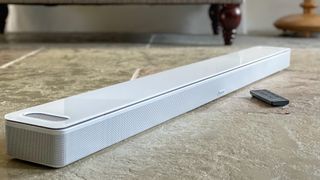

Specifications
Reasons to buy
Reasons to avoid
✅ Stunning good looks. With its glass top surface and metal surround, the soundbar looks lovely.
✅ Excellent sound. The soundbar features 9 drivers for great movie sound and good Dolby Atmos.
✅ loads of smarts. The smart soundbar is filled with clever tech, as well as Alexa support.
❌ Voice clarity is better elsewhere. The AI voice enhancement could be better.
❌ Not very bassy. The soundbars bass reproduction isn't great in some circumstances.
Boses' soundbar line is one of the most popular around — and for good reason. They are really good, and sitting at the top of the tree is this, the Bose Smart Ultra soundbar. It's a large unit, made out of glass and metal, and we think it's one of the best-looking soundbars you can buy today. There's a kind of modernism to its design, and while it's the design antithesis to the simplicity of the Sonos Arc Ultra, it'll easily fit into any kind of room decor — whether you choose the black or the white option.
But the core of any soundbar is, as you might imagine, the sound. The 5.1.2 Dolby Atmos sound that the Smart Ultra soundbar is almost entirely excellent. For movies, it's rich and full, with great surround and good height. Explosions in our test films rumbled, music was strong, and the dynamics were good. It does trip up slightly when things get really low, with some hiccups in bass reproduction and AI voice enhancement made things like the news feel synthetic, but overall, it sounds great.
The smart features are what landed the bar on this guide, however. Thanks to a WiFi connection, we found it super easy to send music wirelessly to the bar. Bose's smart speaker ecosystem is very good, and it extends to the Smart Ultra soundbar. Alexa support means you can command the bar without the need for your controller to be nearby. Want it quieter? Tell it! Need more volume? A quick voice prompt, and the volume turns down.
Wired connectivity is good too, with HDMI, optical, and ethernet putting it a connection above the top-ranking Sonos. It's not cheap, but you get a stunning-looking and sounding soundbar for the large outlay.
Read our full Bose Smart Ultra soundbar review.
Best Budget Surround


Specifications
Reasons to buy
Reasons to avoid
✅ All-inclusive package. You Get everything you need for a true surround setup in the box.
✅ Great price. Despite everything you get in the box, the soundbar still doesn't cost a whole lot of money.
✅ Plenty of volume. It will fill even the largest room in your house thanks to loud volume.
❌ Tricky setup. Dialing in the sound takes some work
❌ Not the most engaging Atmos. The up-firing drivers aren't in the best place for good height channels.
Getting hold of a soundbar that features a full surround setup straight from the box isn't easy, but the M512a-H6 makes the process a whole lot easier. For just $449, we get the soundbar itself, a large, powerful sub, and a pair of true surround satellite speakers. That's a whole lot of stuff in one box for the price — but it's on the list not just for the value on hand, but because all that stuff is very good.
Those extra surround speakers wirelessly connect to the soundbar, and allow for greater surround than is otherwise possible with just a soundbar. They make your movies sound like they're really all around you, and they're generally something that you have to buy separately with other devices. We found them great for a wide range of movies in our testing.
Now, you can't expect performance like you'll find on those twice the price, but thanks to those extra surrounds and the included subwoofer the M512-a sounds excellent. It's got a lovely low-end, with plenty of rumble for explosions and other low sounds in your movies. The dialogue reproduction is good too, giving clarity in movies, TV, and even the news.
There's no WiFi as you might find on some of the more expensive options, and you need to dial in the sound to make sure that the surround sounds as good as possible, but for $449, you're not going to find a better surround sound experience.
Read our full Vizio M-Series M512a-H6 review.
Best Mini

Specifications
Reasons to buy
Reasons to avoid
✅ Compact form factor. The Ambeo mini is, as you might expect, small.
✅ Great surround support. There's solid virtual surround on board with 7.1.4 setup.
✅ On board smarts. The soundbar connects to Alexa for some great voice control.
❌ Not much bass. It's small, so there's not as much bass reproduction out of the bar.
❌ Not many connection options. There's WiFi and a single HDMI port.
If you have a small room, you probably don't have the space for a full soundbar, but you still want the best sound possible for your TV. The Ambeo mini soundbar is a great option, packing in great sound that belies its otherwise small size.
Sennheiser is known for incredible sound, and the Ambeo mini delivers. The bass might not be quite as deep as you might want for your movies, but the rest of the soundscape is excellent. Watching most content on your TV will sound infinitely better than the speakers built into your TV, especially as the center channel cleans up the dialogue.
I also think it looks pretty good too, thanks to its wraparound grille and clean top panel. It'll easily fit into whatever room you might want to place it in, that's for sure.
It's not the cheapest option around, but you get what you pay for with the Ambeo mini. If you want more bass than the base unit is capable of, make sure you pick up the Ambeo sub separately. It will cost you more, but it will bring that low-end that the soundbar is otherwise lacking.
Read our full Sennheiser Ambeo Soundbar Mini review.
Best Built-in Subwoofer
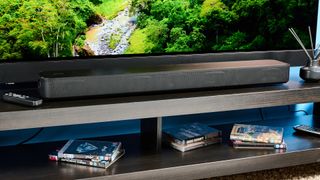
Specifications
Reasons to buy
Reasons to avoid
✅ Built-in sub. Plenty of bass from just the bar.
✅ Excellent price. The bar costs less than other virtual Atmos bars.
✅ Great dialogue. Speech sounds crisp and clear.
❌ No smarts. There's no voice control built into the bar.
❌ No streaming. There's no WiFi to stream audio.
For those looking to upgrade their home system or taking their first steps into the world of home theatre, the Sony HT-S2000 is a fantastic mid–range soundbar that delivers big sound. It’s best suited for 40-inch TVs or larger, and it sports a minimalist, low-profile design that helps it fit into most existing setups.
The HT-S2000 is a 3.1-channel soundbar that utilizes five speakers which include two dedicated woofers for the bass. Dolby Atmos is the big star here and the soundbar very closely replicates finer notes in movies like Top Gun: Maverick and Interstellar. The sound profile is well-balanced with fantastic highs, lows, and mids. Explosions are loud but never too loud that they'll hurt your ears, while the dialog is crisp and crystal clear.
In addition, the HT-S2000’s S-Force Pro Front Surround creates a virtual ‘wraparound’ so it sounds like different sounds are coming from different parts of the room, therefore creating an immersive environment. You also get dedicated Night and Voice modes to enhance dialogues or reduce them, and these worked well in our testing.
There’s no voice assistant support, though, and AirPlay and Wi-Fi streaming have been sacrificed. But you do get Bluetooth 5.2 if you want to play music from your smartphone. For less than $500, the HT-S2000 is a powerful soundbar ideal for elevating your home system.
Read our full Sony HT-S2000 review
Best Budget soundbar & Subwoofer

Specifications
Reasons to buy
Reasons to avoid
✅ Excellent Atmos. The Dolby Atmos drivers are more than capable of filling a room.
✅ Good looks. The sleek bar will slip into any interior decor.
✅ Wireless sub. No wires to trail around the house.
❌ No voice control. There's no support for smart home audio
❌ Some of the modes are off. With the lower bass comes less dialog clarity.
The Polk Audio Signa S4 soundbar + subwoofer absolutely blew us away in testing. Considering its price of under $400, the Signa S4 is a mighty confident contender in the soundbar department. Pricing this at $399 is almost cocky. Surely a soundbar and subwoofer can’t perform well at that price? Well, you’d be wrong.
We tested the Polk Audio Signa S4 with our benchmark movie: ‘Top Gun: Maverick’. This action movie is stuffed full of bombastic jet engines, subtle clinks of metal and swooshes of rope, and of course, conversations uttered entirely over headsets. All that makes for a complex and tricky-to-translate soundscape. However, the Polk Audio Signa S4 made light work of the challenge.
In movie mode, the soundbar + subwoofer combo translated high-octane bass with the proverbial power of the fighter plane engines onscreen. During testing, one of our colleagues in the office below the testing suite complained about the noise. Thankfully, when you don’t want to disturb your neighbours, the Signa S4 comes with a handy ‘night’ mode, which reduces bass. Unfortunately this mode reduced bass and also vocal warmth, so we wouldn’t recommend this mode unless it’s utterly necessary. That’s not a negative of the soundbar at all — night mode does what it intends to — but it works much better in movie mode. In movie mode, the Dolby Atmos performance is completely surround-sound and utterly immersive, perfect for that cinematic experience.
The Signa S4 also has three vocal adjustment modes, which increases the volume of dialogue in action scenes. There are three settings so you can be sure to find one that suits your preferences. There’s also a music mode and you can increase or decrease bass independently of prescribed settings, so hopefully the Polk Audio Signa S4 can please everyone.
This soundbar + subwoofer combo is best for hi-fi newcomers, who may not want to splurge on a soundbar and dedicated sub just quite yet. You won’t be disappointed by the sound quality for the price, not one little bit.
Read our full Polk Audio Signa S4 review
Best soundbars: specs compared
| Header Cell - Column 0 | Dolby Atmos | Audio channels | Power output (rated) | Wireless connectivity | Inputs/outputs | Subwoofer |
|---|---|---|---|---|---|---|
Sonos Arc Ultra | Not specified | 9.1.4 | Not specified | Wi-Fi and AirPlay 2, Bluetooth | Ethernet, HDMI (ARC) | Available separately |
Yamaha YAS-209 | No | Not specified | 200W + 100W | Wi-Fi, Bluetooth | 1x HDMI in, 1x HDMI out, 1x Optical in | Yes (wireless) |
Samsung HW-Q990B | Yes | 11.1.4 | 656W | AirPlay 2, Bluetooth SBC, AAC, Spotify Connect | 2x HDMI in, 1x HDMI out (eARC/ARC), Digital optical | Yes (wireless) |
Devialet Dione | Yes | 5.1.2 | 950W | AirPlay 2, Bluetooth 5.0, Spotify Connect, UPnP | 1x HDMI in, 1x HDMI out (eARC/ARC). Digital optical, Ethernet | Built-in |
Bowers & Wilkins Panorama 3 | Yes | 3.1.2 | 400W | AirPlay 2, Bluetooth aptX Adaptive, Spotify Connect | HDMI, Digital optical, Ethernet | Built-in |
Sony HT-A7000 | Yes | 7.1.2 | 500W | Wi-Fi, AirPlay 2, Bluetooth SBC, AAC, LDAC, Chromecast, Spotify Connect | 2x HDMI in, 1x HDMI out (eARC/ARC), Digital optical, 3.5mm analog audio jack in, USB-A, Ethernet | Available separately |
Polk MagniFi Mini | No | 5.1 | Not specified | Bluetooth | HDMI, Digital Optical, Ethernet, USB | Yes (wireless) |
Bose Smart Ultra Soundbar | Yes | 5.1.2 | Not specified | Wi-Fi, Bluetooth, AirPlay 2, Chromecast, Spotify Connect | HDMI eARC, Optical input, Ethernet port, ADAPTiQ port | Available separately |
Not sure what those different specs all mean? Here's a quick explainer:
Dolby Atmos
The current industry standard for spatial audio and the best surround sound you'll ever find. It makes things above you sound like they're coming from above you while you're watching your movies, thanks to height surrounds. The content you're watching has to be compatible with the standard — although there are more and more ways to watch and listen to spatial audio movies and music than ever thanks to services like NetFlix, Disney Plus, and Apple Music.
Audio Channels
This tells you how many different stereo and surround sections the soundbar has. Usually, in home cinema terms, that would mean how many speakers you've got dotted around the room, but with soundbars, it's often virtual speakers using clever audio trickery to make the sound move around your space. Generally, there are three numbers. The first is your stereo and surround channels. The second number relates to subwoofer channels, and then the final number is Atmos height channels.
Power Output
In audio land, we measure the power an amplifier has by the number of watts it uses to power the speakers attached to it. Generally, the higher the wattage, the more power on tap and the louder the soundbar will go.
Wireless connections
An HDMI connection often isn't the only way to connect to your soundbar. There are other connections available, like AirPlay 2 and Bluetooth for streaming audio. Be aware that only some of these work with your Soundbars Atmos playback, so make sure you check the product's full specs and read our detailed reviews for more information.
Inputs/outputs
This is where you can find out how many things you can plug in, and what kind of ports you can use. Generally, it'll be HDMI, optical, or USB, but some do offer other plugging options.
Subwoofer
Some soundbars come with a bass-producing subwoofer in the box, some have one available separately, and some don't support subwoofers at all. A sub is the best way to get that cinema theater-like bassy rumble that you want for all your action movie watching.
Also tested
Samsung HW-Q990B (★★★★☆)
Right out of the box you have yourself an 11.1.4 surround sound system that is powerful and sleek while still being easy to set up and install. Adaptive Sound uses built-in microphones to adjust the output to your surroundings, and can help boost the height speakers. It’s not quite as feature-complete as we’d like at this price, but if you’re looking for a strong soundbar that can rattle the windows, the Samsung HW-Q990B is worth auditioning.
How we test the best soundbars
Testing the best soundbars is something we take great pride and care in at Tom's Guide. After all, these devices are going to take center stage in your living room below your TV, so we want to be as thorough as possible to help you make an informed buying decision.
To that end, we test all soundbars that come across our testing table in the exact kind of environment that you'll be placing yours into — a medium living room, replete with couches and decorations. That way we can get an idea of how the soundbar performs in the most likely place that it will find itself when unboxed.
Then we test the process it takes the soundbar to connect to your TV. Do you need to connect it to WiFi? Which plugs need to be plugged in? What do you need to change in your TV settings to get it to work properly? If one of these is difficult at all, we report in our review.

Once set up, we make sure to bed the soundbar in. There is some contention to the idea that a speaker needs time to break in, but we've found that after a few hours of medium-level audio on first turn-on makes sure the unit performs its best over the course of your use.
From there we get into the meat and potatoes of the soundbar — the sound tests. We start with TV shows and measure how good the dialogue performance is for news bulletins, and other shows that you might watch every day on your TV. After all, your soundbar might be excellent for movies, but it also needs to do a good job with everyday TV as well.
Then we move on to movies, where we test surround and Atmos performance. We watch a range of different movies, and then we record our findings in our review. That will give you a real-world reference of how the soundbar sounds for your favorite movies, and we make sure to use a range of different films so that we hit as many tastes as possible.
We also test music performance, generally using the best connection possible and Spatial Audio using Apple Music. That gives us the best picture of musical performance possible.
Finally, we test the apps that might connect to the soundbar to get an idea of how the extra features might perform. At the end of our testing, we write our review based on our findings. For more information, check out how we test.
How to choose the best soundbar for you
1. Soundbar size: There are a number of factors that play into deciding which soundbar you should buy. Size will likely be prohibitive for most customers; you obviously need a soundbar that will suit your TV and space constraints within your entertainment console. And, because a soundbar is one of the centerpieces of your home theater setup, it has to look good and fit stylistically.
Then you have to factor in the size of the room you're dealing with, and the distance viewers would typically be sitting from the TV. If you're dealing with a larger space, it's probably best to target soundbars that come with a subwoofer — you'll surely appreciate the extra bass.
2. Dolby Atmos: More and more of the best soundbars are embracing Dolby Atmos, which is a surround sound technology designed to simulate the immersive 3D audio you'd get from a movie theater. The big difference between Atmos and traditional surround sound is that you'll hear sound move up and down and not just side-to-side, allowing you to get extra immersed when, say, a car flies overhead in an action movie. For more a in-depth explanation and to find out how to get it, see Dolby Atmos explained.
3. Connectivity: Connectivity is crucial too, both in terms of wired and wireless access. Not every soundbar comes with an HDMI port; some force you to make do with optical audio. That's perfectly fine if you want to use your TV as a pass-through, but those who are in dire need of more HDMI ports — because their capacity is limited between game consoles, streaming boxes and so on — will need to prioritize options that offer those additional connections.
4. Pricing considerations: Obviously, price is a big consideration when looking for the best soundbars. Although there are always exceptions, big-name brands will typically command a bit extra, but generally speaking, the less you spend on a soundbar the greater the chance that sound and features will be compromised. Going for a budget option isn't always the best choice, as any money you save on your purchase won't do you much good if the sound quality is poor.
As the saying goes: timing is everything; and right now there are plenty of sales on with many of our favorite models discounted at online retailers, meaning you can bag a bargain for even less. Bookmark our best tech deals page to keep track of the latest savings.
Frequently asked questions
How to get the best sound from a soundbar?
Getting the best sound from a soundbar isn't tricky, but there are some basic placement factors to get right. Along with guidance provided in the maker's set-up instructions, the shape of the soundbar itself should offer some clues as to how best to position it in your room.
As with all speakers, the first thing to remember is that they need space to do their job, particularly if your soundbar has upward or side-firing drivers as can often be found in models with Dolby Atmos support. It's not a good idea to place a soundbar behind a TV or in line with any other objects as this will have an impact on how effectively the speakers are able project sound to your seating area. Also, if you place a soundbar too far inside a TV cabinet, it won't project sound out to your sofa as effectively. The TV cabinet enclosure could also have a detrimental effect on the overall quality of the sound.
Generally speaking, a soundbar should ideally be placed centrally with the screen (this helps aesthetically, too) in as much free space as is practical. It can be placed either above or below the TV screen. Many soundbar owners place the soundbar beneath their screen at the foot of the TV stand. This close proximity between sound and screen helps make it feel like the sound and picture are coming from the same location and in sync.
If you're placing a soundbar on top of the TV stand just beneath the screen, be careful to avoid fouling the bottom of the screen and obscuring the lower part of the picture. This may also block signals to the IR sensor from your remote control. If this does happen, a good solution is to raise the TV up slightly or place the soundbar on a lower shelf of the TV stand. If the soundbar does foul the TV's IR sensor, check to see whether it comes with an IR repeater.
Most soundbars are tabletop designs, meaning they can easily be placed on a TV cabinet without taking up too much room. Some soundbars can also be wall mounted, although you'd be wise to check the maker's instructions and consider any structural factors before embarking on wall mounting any soundbar.
Lastly, pay attention to whether your soundbar has any rear bass ports or rear speakers designed to bounce sound off nearby walls behind the TV, say. Ideally these need be kept free from any immediate obstructions that get in the way of speaker's soundwaves, but close enough to any wall structures to allow them to perform effectively.
Always check the maker's guidance for placement advice on your specific soundbar speaker system to make sure you're getting optimal performance and the best sound.
What are all those channel numbers, and what do they mean?
When you're looking for a new soundbar, you've probably seen all those weird numbers in the spec sheets — and then you're left wondering what on earth they mean. Those are channels, and they tell you about the number of physical (or virtual) speakers you've got in your sound bar. Let's talk you through it.
Channel numbers are generally split into three. There's the first number, which denotes the stereo and surrounds speakers, the second number, which tells you how many subwoofers you've got, and the third, which signifies the number of Dolby Atmos drivers there are.
The first number generally tells you what kind of setup that most of the speakers are. For example, in a 3.1 system you'll have two stereo speakers, the left and right channels, and then a center channel, which is used mainly for dialogue. Then, you might find something with 5.1, which means you've got an extra surround speakers to make your audio sound wider, and more immersive. Finally, you'll find something with a 7.1 moniker, so you'll have an extra two drivers — usually rear speakers to really up the surround sound ante.
The second number is easier to decipher, and generally with soundbars, you'll only find a .1. That means that there's either a built-in subwoofer, or one that you connect seperately. You might find something with a .2, which means you've got 2 subwoofers — and so on and so forth.
Finally, you'll find the third number which tells you how many height speakers you've got. On soundbars that'll mean upfiring drivers, which send audio toward your cieling, which then bounces back down to your ears for audio that sounds like it's coming from above. That means helicopters sound like they're landing over head, or fishes swim above you in nature documentaries. You might find a system with 3.1.2 — that means you've got 2 height channels, and then you'll find they go up from there.
Let's put all that into practice. Your soundbar might be a 5.1.2 — that means you've got 5 stereo and surround speakers, most likely a center channel, left and right stereo, and then a pair of surround channels on that sit either side of you. Then, you've got a subwoofer, and finally, 2 height channels for Dolby Atmos.
Let's make another example. This time, you might have a 7.2.4 (although you'll likely not spot a soundbar with this setup). In this configuration, you have 7 surround and stereo channels — a center channel, 2 stereo channels, 2 surround, and 2 rear. Then, you've got 2 subwoofer channels, for loads of bass. Finally, you've got four height channels to really add some Dolby Atmos wallop.
If you're still not sure what channels you're getting, double check the spec sheets of your chosen soundbar — it will generally give you a breakdown.
Sign up to get the BEST of Tom's Guide direct to your inbox.
Get instant access to breaking news, the hottest reviews, great deals and helpful tips.

Tammy and her generous collection of headphones have found a new home — Tom's Guide! After a two-and-a-half-year stint as iMore's resident audiophile, Tammy's reviews and buying guide expertise have more focus than ever on Tom's Guide, helping buyers find the audio gear that works best for them. Tammy has worked with some of the most desirable audio brands on the planet in her time writing about headphones, speakers, and more, bringing a consumer focussed approach to critique and buying advice. Away from her desk, you'll probably find her in the countryside writing (extremely bad) poetry, or putting her screenwriting Masters to good use creating screenplays that'll never see the light of day.

